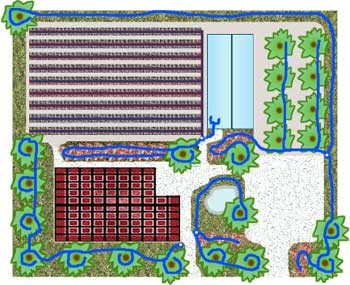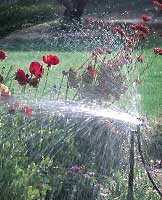Some OF THE technical parameters to consider when designing an irrigation system
We have made a small diagram below to illustrate, using a simple example, to show you how you can roughly design irrigation of a small area using drip irrigation. Please keep in mind that there are no ready-made solutions for all occasions, and the given examples cannot be taken as a rule for all real-life situations. The purpose of this article is to show you the right direction and give you a site planning methodology. Get creative with this task, try to draw several options and calculate them. So you can make the optimal and cost-effective version of your individual project, which is most suitable for your specific site.
Don't take the job of planning irrigation for your site too seriously. And probably you shouldn't calculate all the smallest details. Then in practice, it may turn out that you want to change something, move it, or do it differently. Almost all components of the drip irrigation system can be dismantled and then reassembled. Therefore, do not make your project "forever". Relax and try an evening or two, imagine yourself as a landscape designer, but not a simple one, but a specialist who knows all the intricacies of arranging a site, all the tricks of drip irrigation systems, and design your own site that is not afraid of drought, dry wind, or July heat! |
Let's take a look at the diagram and try to select the necessary equipment for it.This section is divided into several zones: - Residential building, framed on both sides by a lawn, trees grow there.
- Garden. He's upstairs - left
- Greenhouse.
- To the right of the house is a lawn with a flower garden and a small pool or decorative pond. It has a flower bed and several trees.
- Even more to the right is a platform for your car
- Above is the garden
- Ornamental or fruit shrubs or climbing plants that form a hedge can be placed along the perimeter of the site, along the fence.
|
Water supply: |
The first step in planning a system is to identify the irrigated areas, and you should consider what kind of water source your site has. It can be a water supply system, a well, a well, or a container with water installed at a height. In the diagram, you can see that each irrigated zone has a point to which you can connect, and from it, you can make irrigation wiring. A very important point: plan the piping around the site so that irrigation can be easily and conveniently connected. It is advisable to make this wiring with plastic pipes buried in the ground. Well, do not forget to connect your distribution network to the main source of water supply! |
Basic rules, or how not to accidentally step on a rake.In nature, unfortunately, there are laws of physics that you and I cannot bypass or deceive. Therefore, try to follow these rules, and the irrigation system on your site will always work "perfectly"! Rule 1: You cannot use more water for irrigation than your water supply can supply! If you can get, for example, 1000 liters of water per hour from your tap, you cannot irrigate several zones at the same time, with total water consumption of 2000 liters. Therefore, water each designated area on your site in turn.
Rule 2: You must have pressure in your network that matches the equipment. Usually, it is 0.5-2.0 atm. If the pressure is lower, you will not get the calculated irrigation rate, but if the pressure is higher, then you will have to use pressure regulators that will lower it to the required level.
Rule 3: Only a certain amount of water can flow through a pipe of a given diameter at operating pressure! For example 1/2-inch drip tubing or hose - 16 mm ID. at a pressure of 2.5 atm. can pass through itself about 750 liters of water per hour. When calculating the number of droppers multiplied by the productivity of the 1st dropper per hour, or the number of sprinklers per water flow rate of each sprinkler per hour, determine the maximum number of them connected to one pipe.
Rule 4: You cannot use unlimited length drip hoses on the same line! Even if you have one single drip at the end of the line, you cannot use any length of hose you want. Again the laws of physics get in our way! For every meter of length of your tube, you lose some of the water pressure, due to the effect of rubbing the water against the tube wall. For all types of drip irrigation hoses, a maximum length is given for each type of hose. Use the datasheets and you won't have these problems. Actually, most of the problems described here are unlikely to occur in practice if your site is not too large, nevertheless, when designing irrigation, remember these rules.
|
Calculation of the maximum amount of water from a water supply source.Prepare some kind of empty container, the volume of which you know. Turn on the water and refill the container. Time yourself. For example a glass 10-liter bottle, you filled in 1 minute. Further, there is a simple arithmetic: 10x60 = 600 liters per hour! This is the maximum water that you can use within one hour. Note that if, for example, at the same time you use water for other needs, then less water will be spent on irrigation. calculate the supply of water for irrigation with a margin, and measure the flow rate of your water source, under the most unfavorable conditions, for example, during hours when all your neighbors are busy with irrigation. |
Calculation of irrigation zones.Now that you know how much water you can take for irrigation, you can calculate the number of irrigation zones. For example, in our diagram above, there is the largest water consumer: a vegetable garden. In the garden, we have 9 beds, 20 meters long. We use, for example, a hose with built-in drippers. The distance between the droppers is 25 cm. The productivity of each dropper is 2 liters per hour. - The total length of the hose is 180 meters.
- Number of droppers - 180: 0.25 = 720 droppers
- Water consumption per hour - 720x2 = 1440 liters per hour.
Here we are faced with the first problem! Our water source can only give 600 liters per hour! How to solve the problem? We'll have to split the garden into 2 or 3 irrigated zones! In principle, we need to do this, since different vegetables grow in the garden, and they also have different water requirements. Another way to solve the problem is to use hoses with a large distance between the droppers, for example, 33 or 40 centimeters and droppers with a lower flow rate. water, for example, 1.5 liters per drip chamber. By calculating the water consumption of each irrigation zone, you can determine whether several zones can be turned on at the same time. Do you have enough water to irrigate them, or do the irrigated zones need to be switched on in turn, so that the plants are watered and there is enough water for irrigation? |
Drip irrigation or micro sprinklers?В статье о капельном орошении, мы решили написать и о применении миниспринклеров. Почему? 
The choice of one of these two types of irrigation is always a matter and right of the owner of the site. Actually, there are special adherents of both one and the other way of watering. We will only try to give some recommendations: try to give some recommendations: |
- Vegetables, shrubs, most types of trees, it is better to irrigate with drip irrigation.
- Lawns, flower beds, and some shallow-rooted trees are best watered with micro-sprinklers.
Advantages and disadvantages of using mini sprinklers: - For uniform watering of large areas, it is better to use sprinklers so as not to install hundreds of meters of hoses with droppers.
- The disadvantage is that you can water areas, such as paths, that do not need to be watered, and this will create excellent conditions for weeds to grow. By the way, this also applies to the garden.
When calculating irrigation with micro-sprinklers, take into account the radius of the irrigated circle, the type of jet, the water flow rate of each sprinkler, the working pressure. There are sprinklers that allow irrigation of a full circle, and there are those that irrigate a sector of 180 or 90 degrees. When planning an irrigation zone, you should take into account all these features and select sprinklers depending on your needs, according to their technical characteristics. Please note that some sprinklers have replaceable nozzles that give different degrees of spray, and some sprinklers allow you to adjust the radius and sector of the irrigation. |